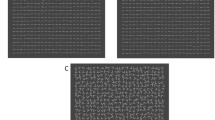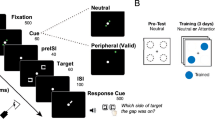Abstract
Perceptual learning may be accompanied by physiological changes in early visual cortex. We used transcranial magnetic stimulation (TMS) to test the postulate that perceptual learning of a visual task initially performed at 60–65% accuracy strengthens visual processing in early visual cortex. Single pulse TMS was delivered to human occipital cortex at time delays of 70–154 ms after the onset of an odd-element, line orientation discrimination task. When TMS was delivered at a delay of 84 ms or later the accuracy of visual discrimination was transiently degraded in ten subjects. As visual performance in control trials without TMS improved with training, the absolute magnitude of TMS suppression of performance decreased in parallel. This result occurred both when TMS was delivered to broad areas of occipital cortex and when TMS was optimally delivered to early occipital cortex. No change in TMS suppression was observed when three new subjects were given feedback during an odd-element task that did not require substantial perceptual learning. Thus, perceptual learning improved visual performance and reduced TMS suppression of early visual cortex in parallel.







Similar content being viewed by others
References
Adini Y, Sagi D, Tsodyks M (2002) Context-enabled learning in the human visual system. Nature 415:790–793
Ahissar M, Hochstein S (1993) Attentional control of early perceptual learning. Proc Natl Acad Sci USA 90:5718–5722
Ahissar M, Hochstein S (1997) Task difficulty and the specificity of perceptual learning. Nature 387:401–406
Ahissar M, Laiwand R, Kozminsky G, Hochstein S (1998) Learning pop-out detection: building representations for conflicting target-distractor relationships. Vision Res 38:3095–3107
Amassian VE, Cracco RQ, Maccabee PJ, Cracco JB, Rudell A, Eberle L (1989) Suppression of visual perception by magnetic coil stimulation of human occipital cortex. Electroen Clin Neuro 74:458–462
Amassian VE, Cracco RQ, Maccabee PJ, Cracco JB, Rudell AP, Eberle L (1993) Unmasking human visual perception with the magnetic coil and its relationship to hemispheric asymmetry. Brain Res 605:312–316
Anand S, Hotson J (2002) Transcranial magnetic stimulation: Neurophysiological applications and safety. Brain Cognition 50:366–386
Anand S, Olson JD, Hotson JR (1998) Tracing the timing of human analysis of motion and chromatic signals from occipital to temporo-parieto-occipital cortex: a transcranial magnetic stimulation study. Vision Res 38:2619–2627
Ball K, Sekuler R (1982) A specific and enduring improvement in visual motion discrimination. Science 218:697–698
Boroojerdi B, Bushara KO, Corwell B, Immisch I, Battaglia F, Muellbacher W, Cohen LG (2000) Enhanced excitability of the human visual cortex induced by short-term light deprivation. Cereb Cortex 10:529–534
Brainard DH (1997) The psychophysics toolbox. Spat Vis 10:433–436
Brasil-Neto JP, McShane LM, Fuhr P, Hallett M, Cohen LG (1992) Topographic mapping of the human motor cortex with magnetic stimulation: factors affecting accuracy and reproducibility. Electroen Clin Neuro 85:9-16
Campana G, Cowey A, Walsh V (2002) Priming of motion direction and area V5/MT: a test of perceptual memory. Cereb Cortex 12:663–669
Chino YM, Kaas JH, Smith EL 3rd, Langston AL, Cheng H (1992) Rapid reorganization of cortical maps in adult cats following restricted deafferentation in retina. Vision Res 32:789–796
Cohen LG, Roth BJ, Nilsson J, Dang N, Panizza M, Bandinelli S, Friauf W, Hallett M (1990) Effects of coil design on delivery of focal magnetic stimulation. Technical considerations. Electroen Clin Neuro 75:350–357
Corthout E, Uttl B, Walsh V, Hallett M, Cowey A (2000) Plasticity revealed by transcranial magnetic stimulation of early visual cortex. Neuroreport 11:1565–1569
Crist RE, Kapadia MK, Westheimer G, Gilbert CD (1997) Perceptual learning of spatial localization: specificity for orientation, position and context. J Neurophysiol 78:2889–2894
Crist RE, Li W, Gilbert CD (2001) Learning to see: experience and attention in primary visual cortex. Nat Neurosci 4:519–525
Dosher BA, Lu ZL (1998) Perceptual learning reflects external noise filtering and internal noise reduction through channel reweighting. Proc Natl Acad Sci USA 95:13988–13993
Dragoi V, Rivadulla C, Sur M (2001) Foci of orientation plasticity in visual cortex. Nature 411:80–86
Eysel UT, Schweigart G (1999) Increased receptive field size in the surround of chronic lesions in the adult cat visual cortex. Cereb Cortex 9:101–109
Fahle M, Poggio T (2002) Perceptual Learning. The MIT Press, Cambridge
Fahle M, Edelman S, Poggio T (1995) Fast perceptual learning in hyperacuity. Vision Res 35:3003–3013
Fendick M, Westheimer G (1983) Effects of practice and the separation of test targets on foveal and peripheral stereoacuity. Vision Res 23:145–150
Fiorentini A, Berardi N (1980) Perceptual learning specific for orientation and spatial frequency. Nature 287:43–44
Furmanski CS, Engel SA (2000) Perceptual learning in object recognition: object specificity and size invariance. Vision Res 40:473–484
Furmanski CS, Engel SA (2002) Perceptual learning leads to increases in V1 activity. Soc Neurosci Abstr Viewer 721.3
Ghose GM, Yang T, Maunsell JH (2002) Physiological correlates of perceptual learning in monkey V1 and V2. J Neurophysiol 87:1867–1888
Gilbert CD, Wiesel TN (1992) Receptive field dynamics in adult primary visual cortex. Nature 356:150–152
Godde B, Sprengler F, Dinse HR (1996) Associative pairing of tactile stimulation induces somatosensory cortical reorganization in rats and humans. Neuroreport 8:281–285
Godde B, Stauffenberg B, Spengler F, Dinse HR (2000) Tactile coactivation-induced changes in spatial discrimination performance. J Neurosci 20:1597–1604
Grafman J (2002) The use of transcranial magnetic stimulation in learning and memory research. In: Pascual-Leone A, Davey N, Rothwell J, Wassermann E, Puri B (eds) Handbook of transcranial magnetic stimulation. Arnold, London, pp 303–313
Hochstein S, Ahissar M (2002) View from the top: hierarchies and reverse hierarchies in the visual system. Neuron 36:791–804
Hotson JR, Anand S (1999) The selectivity and timing of motion processing in human temporo-parieto-occipital and occipital cortex: a transcranial magnetic stimulation study. Neuropsychologia 37:169–179
Hotson J, Braun D, Herzberg W, Boman D (1994) Transcranial magnetic stimulation of extrastriate cortex degrades human motion direction discrimination. Vision Res 34:2115–2123
Juan CH, Walsh V (2003) Feedback to V1: a reverse hierarchy in vision. Exp Brain Res 150:259–263
Kaas JH, Krubitzer LA, Chino YM, Langston AL, Polley EH, Blair N (1990) Reorganization of retinotopic cortical maps in adult mammals after lesions of the retina. Science 248:229–231
Kammer T (1999) Phosphenes and transient scotomas induced by magnetic stimulation of the occipital lobe: their topographic relationship. Neuropsychologia 37:191–198
Kapadia MK, Ito M, Gilbert CD, Westheimer G (1995) Improvement in visual sensitivity by changes in local context: parallel studies in human observers and in V1 of alert monkeys. Neuron 15:843–856
Karni A, Sagi D (1991) Where practice makes perfect in texture discrimination: evidence for primary visual cortex plasticity. Proc Natl Acad Sci USA 88:4966–4970
Karni A, Weisberg F, Lalonde F, Ungerleider L (1995) An fMRI study of human visual cortex plasticity. Soc Neurosci Abstr 21:276
Kastner S, Demmer I, Ziemann U (1998) Transient visual field defects induced by transcranial magnetic stimulation over human occipital pole. Exp Brain Res 118:19–26
Klaes C, Ragert P, Jancke DE, Tegenthoff M, Dinse H (2003) rTMS induced improvement of human orientation discrimination. Soc Neurosci Abstr Viewer 911:22
Kobatake E, Wang G, Tanaka K (1998) Effects of shape-discrimination training on the selectivity of inferotemporal cells in adult monkeys. J Neurophysiol 80:324–330
Lee TS, Yang CF, Romero RD, Mumford D (2002) Neural activity in early visual cortex reflects behavioral experience and higher-order perceptual saliency. Nat Neurosci 5:589–597
McKee SP, Westheimer G (1978) Improvement in vernier acuity with practice. Percept Psychophys 24:258–262
Neary K, Gee B, Anand S, Hotson J (2001) Does perceptual learning change the effect of transcranial magnetic stimulation (TMS) on visual cortex? Soc Neurosci Abstr Viewer 619:54
Neary K, Anand S, Gee B, Hotson J (2003) Perceptual learning increases the strength of early visual processing as measured by increased resistance to transcranial magnetic stimulation. Invest Ophthalmol Vis Sci 44:4101
Pascual-Leone A, Walsh V (2001) Fast backprojections from the motion to the primary visual area necessary for visual awareness. Science 292:510–512
Pleger B, Dinse HR, Ragert P, Schwenkreis P, Malin JP, Tegenthoff M (2001) Shifts in cortical representations predict human discrimination improvement. Proc Natl Acad Sci USA 98:12255–12260
Polat U, Sagi D (1994) Spatial interactions in human vision: from near to far via experience-dependent cascades of connections. Proc Natl Acad Sci USA 91:1206–1209
Ragert P, Becker M, Tegenthoff M, Pleger B, Dinse HR (2004) Sustained increase of somatosensoy cortex excitability by 5 Hz repetitive transcranial magnetic stimulation studied by paired median nerve stimulation in humans. Neurosci Lett 356:91–94
Rainer G, Lee H, Logothetis NK (2004) The effect of learning on the function of monkey exstrastriate visual cortex. PLoS Bio 2:E44
Ramachandran VS (1976) Learning-like phenomena in stereopsis. Nature 262: 382–384
Recanzone GH, Merzenich MM, Jenkins WM, Grajski KA, Dinse HR (1992a) Topographical reorganization of the hand representation in cortical area 3b of owl monkeys trained in a frequency-discrimination task. J Neurophysiol 67:1031–1056
Recanzone GH, Merzenich MM, Schreiner CE (1992b) Changes in the distributed temporal response properties of S1 cortical neurons reflect improvements in performance on a temporally based tactile discrimination task. J Neurophysiol 67:1071–1091
Roth BJ, Saypol JM, Hallett M, Cohen LG (1991) A theoretical calculation of the electric field induced in the cortex during magnetic stimulation. Electroen Clin Neuro 81:47–56
Schiltz C, Bodart JM, Dubois S, Dejardin S, Michel C, Roucoux A, Crommelinck M, Orban GA (1999) Neuronal mechanisms of perceptual learning: changes in human brain activity with training in orientation discrimination. Neuroimage 9:46–62
Schoups AA, Vogels R, Orban GA (1995) Human perceptual learning in identifying the oblique orientation: retinotopy, orientation specificity and monocularity. J Physiol (Lond) 483.3:797–810
Schoups A, Vogels R, Qian N, Orban G (2001) Practising orientation identification improves orientation coding in V1 neurons. Nature 412:549–553
Schweigart G, Eysel UT (2002) Activity-dependent receptive field changes in the surround of adult cat visual cortex lesions. Eur J Neurosci 15:1585–1596
Teich AF, Qian N (2003) Learning and adaptation in a recurrent model of V1 orientation selectivity. J Neurophysiol 89:2086–2100
Walsh V, Ashbridge E, Cowey A (1998) Cortical plasticity in perceptual learning demonstrated by transcranial magnetic stimulation. Neuropsychologia 36:363–367
Watanabe T, Nanez JE Sr, Koyama S, Mukai I, Liederman J, Saski Y (2002) Greater plasticity in lower-level than higher-level visual motion processing in a passive perceptual learning task. Nat Neurosci 5:1003–1009
Werhahn KJ, Taylor J, Ridding M, Meyer BU, Rothwell JC (1996) Effect of trancranial magnetic stimulation over the cerebellum on the excitability of human motor cortex. Electroen Clin Neuro 101:58–66
Yang T, Maunsell JH (2004) The effect of perceptual learning on neuronal responses in monkey visual area V4. J Neurosci 24:1617–1626
Zohary E, Celebrini C, Britten KH, Newsome WT (1994) Neuronal plasticity that underlies improvement in perceptual performance. Science 263:1289–1292
Acknowledgements
This study was supported by The Valley Foundation, San Jose, CA, USA (J.R.H.)
Author information
Authors and Affiliations
Corresponding author
Rights and permissions
About this article
Cite this article
Neary, K., Anand, S. & Hotson, J.R. Perceptual learning of line orientation modifies the effects of transcranial magnetic stimulation of visual cortex. Exp Brain Res 162, 23–34 (2005). https://doi.org/10.1007/s00221-004-2117-5
Received:
Accepted:
Published:
Issue Date:
DOI: https://doi.org/10.1007/s00221-004-2117-5




